This May and June, we’re taking a trip back in time to review the fifth season of The X-Files and the second season of Millennium.
Suspension of disbelief is a curiously fickle thing.
It is a concept that generates considerable debate in its function and application. After all, the normal mode of fiction generally accepts that fiction is… well, fictional. There is no real belief to shatter, because there is an innate understanding between artist and audience that a work of art should be interpreted as a representation of reality rather than a piece of reality. Even in the case of “true stories”, audiences will willingly and readily accept alterations and adjustments designed to streamline the story in question.
After all, the concept of “suspension of disbelief” is quite firmly disengaged from the concept of reality. The old cliché about “truth being stranger than fiction” illustrates the distinction. The real world (and the stories of the people who inhabit it) are full of coincidences and contrivances that audiences would consider to be lazy writing or poor construction if they appeared in a work of fiction. Nevertheless, while “suspension of disbelief” might be more complex than its three-word nature would suggest, it is a useful philosophy.
What “breaks” a work of fiction? At what point does the artist – whether intentionally or otherwise – push the audience out of the story? What causes a double take to occur or a quizzical eyebrow to raise? What story developments prompt angry sighs or bitter grumbling? There is no hard and fast answer. The line will always be arbitrary, varying from audience member to audience member. Everybody has different expectations when it comes to art, and so that threshold is distinct for every person.
Sometimes people can agree on where the line falls on a certain work, but everybody has their limits. There are some people who embrace perceived absurdities or inconsistencies or incongruities in their stories; there are some people who simple do not consider those absurdities or inconsistencies or incongruities to exist at all. One of the great things about The X-Files as a television show is the sense of adventure and excitement that the premise generates. It is highly flexible, allowing for almost anything.
At the same time, it seems quite clear that writer John Rozum and artist Alex Saviuk find themselves charging head-first towards that highly arbitrary and high flexible boundary with The Face of Extinction, a story about a secret race of intelligent goat people who have lived alongside human civilisation for millennia and who also (conveniently) speak perfect English. It is a rather absurd concept, and one that seems at odds with the relatively grounded style of the first five seasons of The X-Files.
It is a strange development, to be sure. Anthropomorphic animals are quite common in fiction – particularly in books, comics and animation. There is something inherently interesting about animals that resemble people. It makes them interesting allegories for metaphorical storytelling, but it also provides an interesting visual to accompany the story. After all, The Face of Extinction would be a lot less interesting if it were just the story of a vagrant wandering through the woods scaring people.
Of course, these type of effects have traditionally been difficult to realise in live action. Until the advent of CGI, studios were faced with the prospect of using either animatronics or stop-motion. Animatronics were generally quite expensive to produce, while stop-motion was often derided as “cheap” and “silly.” As a result, these sorts of creatures were typically confined to expensive feature films. They were highly unlikely to appear on an episode of The X-Files, even if Chris Carter wanted them. Production constraints would prohibit it.
Even as The X-Files grew more and more adventurous in its second half, it was still a show that was highly unlikely to tell stories about giant goatsmen who spoke English. Whether for aesthetic or production reasons, The X-Files shied away from large-scale “creature” monsters. The attempt to design a human-sized insect in Folie à Deux was ruled such a disaster that the production team blurred the creature in post-production, making it more effective for the fact it was not seen. Even werewolf episodes like Shapes or Alpha minimised exposure to the creature.
As rule, The X-Files generally avoids cryptozoology. When Mulder and Scully investigate the Jersey Devil in The Jersey Devil, they discover that she is simply an evolutionary relic. When Mulder gets excited about encountering the Mothman in Detour, he instead finds a bunch of immortal conquistadors. The production team tended to avoid Bigfoot, only referencing the creature in passing. The comics had a much better time, unimpeded by budget constraints or production realities – with Bigfoot appearing in Big Foot, Warm Heart.
The few times that animalistic monsters appear on The X-Files, the show tends to avoid putting them in focus. The abducted zoo animals in Fearful Symmetry are rendered invisible in order to make life easier on the production team. Big Blue – whether the mythical creature or the hungry crocodile – is kept off-screen for most of Quagmire. In contrast, The Face of Extinction puts its goat people front and centre, revealing that they can talk quite early and even offering a fairly comprehensive history for them.
It is certainly a decision that requires a considerable leap of narrative faith from the audience. it is interesting to wonder where the break in logic occurs. Is a human-sized goat person any more absurd than a humansized fluke worm? After all, if you can make that leap, everything else seems arbitrary. It is akin to complaining about the fact that Superman can fool the best reporters in the world with a pair of glasses, while glossing over the fact that he can fly. It arguably demonstrates just how arbitrary suspension of disbelief can be.
Then again, perhaps that is not an accurate description of the tension. Dismissing the original formulation of “suspension of disbelief”, J.R.R. Tolkien instead suggested in On Fairy Stories that audiences were really looking for internal consistency in their tales:
What really happens is that the story-maker proves a successful ‘sub-creator.’ He makes a Secondary World which your mind can enter. Inside it, what he relates is ‘true’: it accords with the laws of that world. You therefore believe it, while you are, as it were, inside. The moment disbelief arises, the spell is broken; the magic, or rather art, has failed. You are then out in the Primary World again, looking at the little abortive Secondary World from outside. If you are obliged, by kindliness or circumstance, to stay. Then disbelief must be suspended (or stifled), otherwise listening and looking would become intolerable.
It is a reasonable explanation, even if exceptions undoubtedly exist. It can be fun to break that internal consistency if breaking the internal consistency is the point of the story – as in deconstruction. Or the story could consciously reject any substantive internal consistency – as in Doctor Who, for example.
As such, the decision to build The Face of Extinction around a collection of satyrs who exist as fully-formed characters (with lots of dialogue and character development) seems to exist at odds with the world of The X-Files. It feels like Mulder and Scully have wandered into a completely different genre – they’ve meandered from the “magical realism” that tends to define fantasy on The X-Files (best demonstrated by episodes like The Goldberg Variation or Closure) towards a much purer and more traditional form of fantasy narrative.
Tolkien proves to be a fairly apt point of reference for The Face of Extinction. In many respects, the story of the goat people feels like something from a fantasy book. Even the dialogue is laced with fantasy clichés. “Humans brought my race close to extinction,” the goat man explains, in dialogue that all but requires an English thespian. As the two last goat people search out another, a dying goat person advises her partner, “You mustn’t let her all into human hands. The fate of our kind depends on it.”
Even the structure of the story recalls the end of The Lord of the Rings, the story of a massive and mystical fantasy world slowly retreating. The goat people are the last remnants of a more magical time, who now find themselves facing extinction. “You’re dealing with the last members of a population of beings once described by Marco Polo and Pliny the Elder,” Landoch explains to Mulder and Scully. The Face of Extinction ends with a more grim take on the sequence where the magical beings depart Middle Earth at the end of The Lord of the Rings.
It is very much an awkward fit for The X-Files, particularly because John Rozum and Alex Saviuk don’t really ease themselves into it. The goat creatures are properly introduced on the second page of the issue. The fact that they can converse in English is not a shocking climactic reveal, but something casually dropped into an early portion of the story. There is no sense that the audience is figuring out what kind of story this is at the same pace of Mulder and Scully. Instead, The Face of Extinction throws the reader in at the deep end.
There is a certain amount of fun to be had in pushing Mulder and Scully out of their element. Darin Morgan’s script for Humbug works because it turns so many assumptions about The X-Files on their head. Glen Morgan and James Wong pushed the show in unexpected and unconventional directions with their four fourth season scripts. Vince Gilligan set The X-Files on a collision course with Cops in X-Cops, an episode that derives a lot of its fun from this strange intersection of two concepts that should not really overlap.
However, The Face of Extinction never really has any fun with the idea that Mulder and Scully are well and truly outside of their comfort zone. The Face of Extinction never really acknowledges that a talking and reasoning goat-person who exists as the last relic of an ancient civilisation is well beyond the novelty of something like Flukeman or Eugene Victor Tooms or even a butt-dwelling Indian fakir. John Rozum never acknowledges this strange and incongruous element as anything other than business as usual for the duo.
The result is a script that feels clumsy and messy, not capitalising on the tension at the heart of the story. Scully gets to make the same excuses that she always makes – arguing that these goat people must be the result of “congenital birth defects.” Rozum does manage to hit on a few big themes of The X-Files – we are told that “encroaching civilisation has further reduced their numbers”, suggesting the same clash of man and nature that the show offered in Darkness Falls or Detour. Sadly, it is not enough to sustain the story.
To be fair, John Rozum is not writing for The X-Files on television. He is writing for a tie-in comic book. As a result, there are different rules and standards in place. As much as the audience respects the conventions of The X-Files, they also instinctively understand that this is a different medium. Stefan Petrucha and Charles Adlard had great fun experimenting with that dissonance, telling X-Files stories that would never have worked on screen. Adventures like Firebird and Silent Cities of the Mind and even One Player Only all lean on this.
The Face of Extinction is an intriguing concept that might have been interesting to explore with a bit more space and a bit more nuance. It is fun to imagine a conspiracy story where Mulder discovers that David Icke’s lizard-people actually exist, even if it would have to be written very carefully. Unfortunately, The Face of Extinction is a story that requires a great deal of care, delivered in the most clumsy manner possible.
Filed under: Comics, The X-Files | Tagged: alex saviuk, cryptozoology, fantasy, goat men, history, john rozum, mulder, mythology, satyrs, the face of extinction, the x-files, tolkien, x-files |



















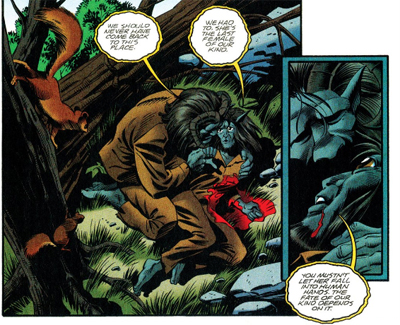
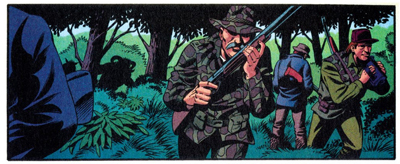
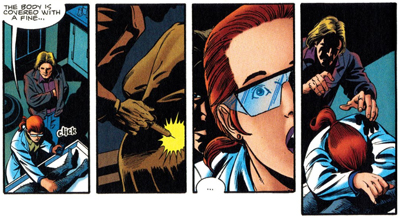
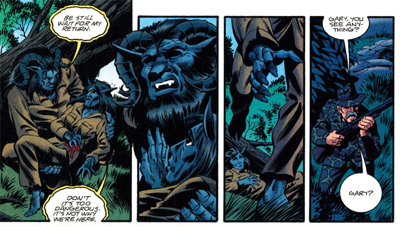
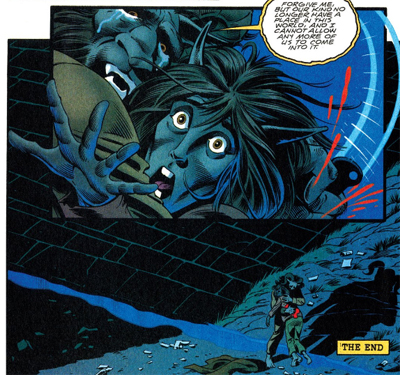

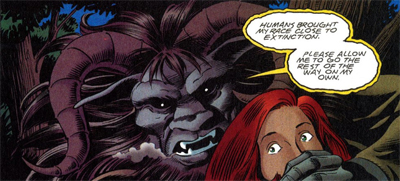





Leave a comment